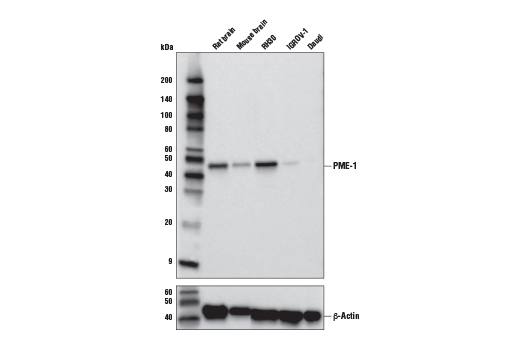WB
H M R
Endogenous
42
Mouse IgG1
#Q9Y570
51400
Product Information
Product Usage Information
| Application | Dilution |
|---|---|
| Western Blotting | 1:1000 |
Storage
Specificity / Sensitivity
Species Reactivity:
Human, Mouse, Rat
Source / Purification
Monoclonal antibody is produced by immunizing animals with recombinant full-length mouse PME-1 protein.
Background
Protein phosphatase methylesterase 1 (PME-1) is an evolutionarily conserved enzyme that demethylates phosphatases (1). Post-translational modification (PTMs) of proteins is a cellular mechanism that increases the functional diversity of the proteome. Several forms of PTMs exist, including methylation and phosphorylation, the covalent addition of a methyl or phosphate group, respectively, to specific amino acids within a protein. In addition to enzymes that catalyze the addition of methyl groups or phosphates to proteins, specific enzymes that remove PTMs exist to provide an additional level of cellular regulation; methyl and phosphate PTMs are removed by methylesterases and phosphatases, respectively. Phosphoprotein phosphatase 2a (PP2A) is an essential serine/threonine phosphatase that, as part of various signal transduction pathways, regulates many fundamental cellular processes, including DNA replication, transcription, translation, metabolism, cell cycle progression, cell division, apoptosis, and development (2-4). PP2A function is regulated, in part, by phospho- and methyl modification of its catalytic subunit. PP2A is methylated at the carboxyl group of the C-terminal Leucine 309 residue by leucine carboxyl methyltransferase (LCMT). Methylation of PP2A alters its cellular localization and its ability to interact with its regulatory subunits and substrates (5-8). PP2A is demethylated by PME-1 (9,10). PME-1 KO mice are post-natal lethal, and KO tissue exhibit altered PP2A activity and phospho-proteomic profile, consistent with a critical role PME-1 plays in regulating PP2A function (11). Dysregulated PP2A activity is linked to several diseases, including certain cancers and neurodegenerative diseases like Alzheimer’s disease, suggesting that PME-1 could be the target of therapeutic intervention (12-14).
- Kaur, A. and Westermarck, J. (2016) Biochem Soc Trans 44, 1683-93.
- Janssens, V. and Goris, J. (2001) Biochem J 353, 417-39.
- Zolnierowicz, S. (2000) Biochem Pharmacol 60, 1225-35.
- Millward, T.A. et al. (1999) Trends Biochem Sci 24, 186-91.
- Favre, B. et al. (1994) J Biol Chem 269, 16311-7.
- De Baere, I. et al. (1999) Biochemistry 38, 16539-47.
- Tolstykh, T. et al. (2000) EMBO J 19, 5682-91.
- Yu, X.X. et al. (2001) Mol Biol Cell 12, 185-99.
- Lee, J. et al. (1996) Proc Natl Acad Sci U S A 93, 6043-7.
- Ogris, E. et al. (1999) J Biol Chem 274, 14382-91.
- Ortega-Gutiérrez, S. et al. (2008) PLoS One 3, e2486.
- Remmerie, M. and Janssens, V. (2019) Front Oncol 9, 462.
- Park, H.J. et al. (2018) J Neuropathol Exp Neurol 77, 139-48.
- Bachovchin, D.A. et al. (2011) Proc Natl Acad Sci U S A 108, 6811-6.
Species Reactivity
Species reactivity is determined by testing in at least one approved application (e.g., western blot).
Western Blot Buffer
IMPORTANT: For western blots, incubate membrane with diluted primary antibody in 5% w/v BSA, 1X TBS, 0.1% Tween® 20 at 4°C with gentle shaking, overnight.
Applications Key
WB: Western Blotting
Cross-Reactivity Key
H: human M: mouse R: rat Hm: hamster Mk: monkey Vir: virus Mi: mink C: chicken Dm: D. melanogaster X: Xenopus Z: zebrafish B: bovine Dg: dog Pg: pig Sc: S. cerevisiae Ce: C. elegans Hr: horse GP: Guinea Pig Rab: rabbit All: all species expected
Trademarks and Patents
Limited Uses
Except as otherwise expressly agreed in a writing signed by a legally authorized representative of CST, the following terms apply to Products provided by CST, its affiliates or its distributors. Any Customer's terms and conditions that are in addition to, or different from, those contained herein, unless separately accepted in writing by a legally authorized representative of CST, are rejected and are of no force or effect.
Products are labeled with For Research Use Only or a similar labeling statement and have not been approved, cleared, or licensed by the FDA or other regulatory foreign or domestic entity, for any purpose. Customer shall not use any Product for any diagnostic or therapeutic purpose, or otherwise in any manner that conflicts with its labeling statement. Products sold or licensed by CST are provided for Customer as the end-user and solely for research and development uses. Any use of Product for diagnostic, prophylactic or therapeutic purposes, or any purchase of Product for resale (alone or as a component) or other commercial purpose, requires a separate license from CST. Customer shall (a) not sell, license, loan, donate or otherwise transfer or make available any Product to any third party, whether alone or in combination with other materials, or use the Products to manufacture any commercial products, (b) not copy, modify, reverse engineer, decompile, disassemble or otherwise attempt to discover the underlying structure or technology of the Products, or use the Products for the purpose of developing any products or services that would compete with CST products or services, (c) not alter or remove from the Products any trademarks, trade names, logos, patent or copyright notices or markings, (d) use the Products solely in accordance with CST Product Terms of Sale and any applicable documentation, and (e) comply with any license, terms of service or similar agreement with respect to any third party products or services used by Customer in connection with the Products.
